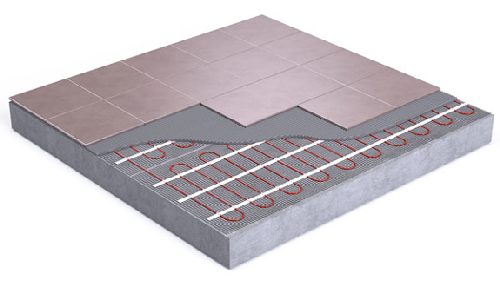What are the advantages of a heated floor?
The heated floort use radiant heat to warm the room. The occupants have an immediate feeling of comfort thanks to this enveloping heat which penetrates when the temperature is cold. Your feet that feel the heat that comes from a ceramic floor in the middle of winter is a very nice feeling! And it's easy to do the energy calculation: greater comfort with less energy expenditure equals a reduction in energy costs.
Apart from providing superior comfort, the Ouellet system we use has several other avantages. It ist clean (dust-free), invisible, silent, compatible with other types of heating, economical (operation costs for one room are equivalent to two 100w bulbs that would remain constantly lit), safe and do not need any particular maintenance. In addition it imposes no architectural constraint since it is hidden in the floor.
More efficient than baseboard heaters and often more efficient than forced air systems that lose heat in metallic conduits.
People who have allergies prefer radiant heat because it does not spread allergens like do forced air systems.
Types of heated floors
Here are the two most popular types of radiant floor heating :
- Electric radiant heating : Heating cables are distributed over the whole surface of the floor by means of a system of insulating strips or plates. The floor covering is then installed. It is compatible with floating floors but ceramics and stone are the best conductors to redistribute heat. Wood and vinyl can be used but are not recommended because of the cracking that can occur with heat. If you really want a wooden floor, it is advisable to use engineered flooring1.
- Hydronic radiant heating : This system operates using a flexible hose network that is incorporated into the concrete slab. The distribution of the liquid passes through collectors. There is also a dry covering system which avoids having to install the piping in the concrete slab. The liquid used in the pipes is a mixture of water and glycol (ethylene glycol or propylene glycol). Both types of glycol are equivalent to the energy level but propylene glycol is the one with the least risk of contamination of soil or water in the event of a leak. It is important to isolate your heating system from the drinking water system.
The heated floor can be used as a primary heating source in a room or as a secondary heat source if only a floor is left that remains warm to improve the comfort of the room.
For the ecologists
The electrically heated floor that was installed on a well-insulated cement base uses cement as the thermal mass. If the thermal mass is of sufficient size, the heat stored in it will keep the room comfortable for a period of eight to ten hours without the heating being activated. This is especially evident when the temperature during the day is significantly warmer than the night. If you are eco-friendly, you can maximize your energy savings by programming your floor heating during off-peak periods.
For renovations
An advantage not to be overlooked for underfloor heating is that it simplifies the heating installation in additional rooms that are added to the house. Sometimes it is not practical to extend the existing heating system in the new part and this is where the heating floor offers a simple and economical solution.
The principle of radiant heating
Radiant heating uses radiation, like the sun, to heat objects.The air around these objects is then heated in turn. This type of heating operates in contrast to other heating modes which attempt to heat the air directly. The transfer of heat is done without air movement, it is the heat that emanates from the floor that radiates objects, walls and ceilings.
Heated floor – Installation on plywood
Heated floor – Installation on concrete screed
